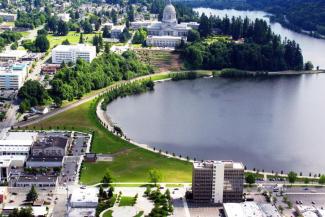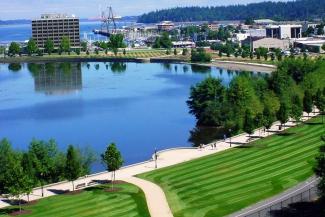Heritage Park
Park hours
Park public restroom hours: 7 a.m. to dusk. Security is provided by the Washington State Patrol.
Parking
Metered city parking can be found on Water Street. There is also a parking lot at 701 Water Street SW, Olympia.
Walk/run the park
Heritage Park is a 24-acre state-owned park adjacent to the State Capitol Campus, Capitol Lake and downtown Olympia. It is the northern extension of the historic West Capitol Campus. It also serves as a symbol of our state’s commitment to community development in harmony with environmental stewardship.
The park features walking/running paths that encircle the entire perimeter of the park and Capitol Lake, and connect to other pedestrian paths. The Heritage Park Trail, a switchback trail at the south end of the park, winds its way up to the historic Capitol Campus on the bluff above.
For more information, see Capitol Lake trails.
Plan an event
With its broad lawns and sweeping views of the Capitol, Heritage Park is a great place to hold festivals, performances, community activities, athletic events and more. A lawn amphitheater area is ideal for small performances and educational events. Ample parking and the amenities of downtown Olympia are right here. For more information:
- Plan an event
- Contact an events coordinator:
Email: campusevents@des.wa.gov
Phone: 360-902-8881
Tour park features and amenities
The design of Heritage Park reflects the state’s intent that the park’s physical features, as well as the installations and interpretive programs it hosts, should represent Washington’s diverse heritage and culture.
- The Arc of Statehood
The 2,500-foot-long pathway along the eastern shore of Capitol Lake is the most prominent architectural feature. It is a convenient place to sit and watch wildlife. “Bump-outs” along the arc provide beautiful views and mark its intersection with the historic northward view axis from the Capitol Campus to Puget Sound. - County markers
Each of Washington’s 39 counties is honored by an individual bronze marker mounted on a sandstone block along the Arc of Statehood. - Environmental and Geologic Heritage
Two prominent viewing points along the lake’s edge represent Washington’s natural diversity. At the southern end of the Arc of Statehood, the “Western Washington Inlet,” is a natural waterfowl habitat representative of much of Western Washington’s coastal and riverine ecosystems. At the northern end of the Arc is the “Eastern Washington Butte.” Still under development, this small hill of earth with its winding footpath will be landscaped as a rocky bluff representative of Eastern Washington’s arid environment. - Steps to Lake Edge
Monumental steps at the eastern shore of Capitol Lake offer lake edge access as well as seating for viewing events on the water. - Outdoor Amphitheater
Though still under development, the park has been gently sculpted to include a lawn amphitheater area. In its current form, it can support audience-style events for large or small groups. - Heritage Park Trail
A switchback trail at the south edge of the park connects to the West Capitol Campus on the bluff above. This wheel-chair accessible, half-mile path tops out at the Law Enforcement Memorial, with a stunning view of Puget Sound and the Olympic Mountains.
Adjacent parks
- Marathon Park
Built in 1969, two-acre Marathon Park commemorates the first U.S. trials for the Women’s Olympic Marathon that began and ended at the park site. A trail through the park connects it to Heritage Park. Marathon Park is also a favorite for car shows, dances, family reunions, weddings and other outdoor events. - Capitol Lake Interpretive Center
The Interpretive Center at the northern end of Capitol Lake marks the marks the start of a walking trail through wetlands. - Heritage Park Fountain
Across 5th Avenue at the north east corner of Heritage Park, the Heritage Park Fountain is owned and operated by the City of Olympia.
Visit other state and local attractions
- City of Lacey parks and recreation
- City of Olympia events and activities
- City of Tumwater tourism and visitor information
- Washington State Parks
- Washington State Tourism
Park history
The first Master Plan for Washington’s Capitol designed in 1911 included an open space connecting the state capitol buildings with downtown Olympia and Puget Sound. Heritage Park fulfills that vision.
Planning for park development began in 1986, when the City of Olympia commissioned a study on the possibility of creating the space envisioned by capitol architects Walter Wilder and Harry White. The result was a contemporary interpretation of the 1911 design: a public park with a promenade aligned along a north-south axis from the center of the Legislative Building to Puget Sound. Though the park design has evolved considerably from the 1986 study, the historic axis serves as a central design feature of the park today.
Soon after this first study, the Heritage Park Development Association was formed. The association, composed of private citizens from across the state encouraged cooperation between the state and the city to promote continued planning and investment in the park. The group remains active today.
The first state funding for the park was authorized in 1991. It enabled the purchase of critical park property and funded further study. The Heritage Park pre-Design Study was completed in 1992, and serves today as the primary vision guiding ongoing park development.
Subsequent state money paid for the park’s physical formation, infrastructure and initial landscaping.

